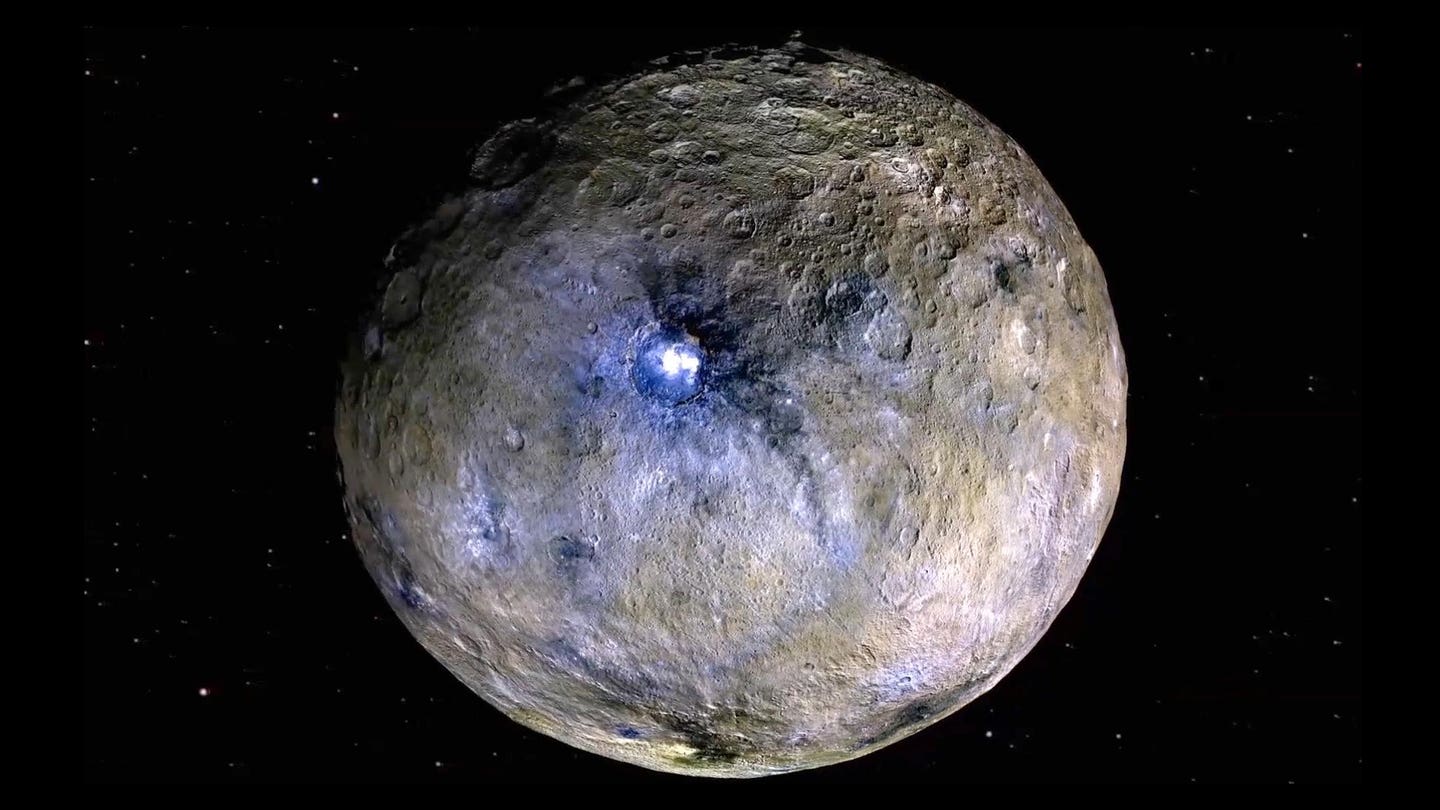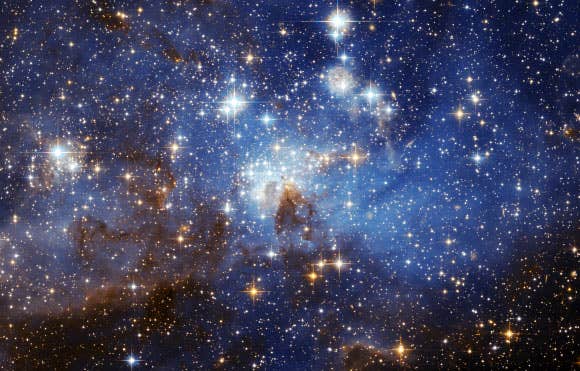Dwarf planet Ceres holds evidence of life’s cosmic origins
Organic material on Ceres may have originated from asteroid impacts rather than cryovolcanism, revealing new insights into the Solar System’s history.

Scientists have detected organic molecules on Ceres, but their origin remains a mystery. (CREDIT: NASA)
Ceres, the largest object in the asteroid belt, may hold answers to fundamental questions about the Solar System. This dwarf planet, positioned between Mars and Jupiter, is the only inner Solar System body that could be considered an "ocean world." Scientists believe its icy subsurface could have preserved water for billions of years. But what makes Ceres even more intriguing is the presence of organic material—key building blocks of life.
NASA's Dawn mission, which orbited Ceres from 2015 to 2018, revealed surprising details about its composition. Data from the mission confirmed the presence of organic-rich regions, especially around the Ernutet crater.
These findings add Ceres to a short list of Solar System bodies known to host complex organic compounds, a characteristic often associated with objects much farther from the Sun.
Organic materials can originate in multiple ways. Some form in deep space, within molecular clouds and stellar ejecta, and later get incorporated into asteroids and planets. Others are created through internal processes, such as volcanic activity or chemical reactions within a planetary body. Understanding where the organics on Ceres come from could help scientists determine whether life-friendly environments have existed beyond Earth.
Unusual Organic Patches
Ceres' organic-rich regions are not evenly distributed across its surface. Instead, these materials appear in small, isolated patches, mainly around the Ernutet crater. The deposits stretch over an area of about 1,000 square kilometers and extend into neighboring craters, including Hakyumi and Omonga. Additional organic sites exist at craters like Inamahari and Urvara, but they are far from the primary cluster near Ernutet.
Identifying organic materials remotely requires specialized tools. The Dawn spacecraft used spectrometers to analyze light reflected from the surface. Certain molecular structures absorb light at specific wavelengths, allowing scientists to determine their composition.
Organic molecules, particularly aliphatic hydrocarbons, exhibit absorption features near 3.4 micrometers in the infrared spectrum. However, distinguishing them from carbonates—common on Ceres—requires a closer look at spectral signatures around 4.0 micrometers.
Another key indicator of organic material is a "red slope" in the visible and near-infrared spectrum. This effect, caused by electronic transitions in carbon, increases reflectance at longer wavelengths. Scientists found that the organic deposits on Ceres displayed this red-sloped signature, which is more commonly seen on objects in the outer Solar System. This observation raised an important question: Did these organics originate on Ceres, or were they delivered by impacts?
Related Stories
Tracing the Origins
Organic molecules are essential for life, but their presence does not necessarily mean life existed. They can form naturally in space and accumulate on planetary surfaces over time.
Some of the oldest bodies in the Solar System, including comets and Kuiper Belt objects, contain these molecules in abundance. On Ceres, the key question is whether the detected organics were generated internally or arrived from elsewhere.
The possibility of an endogenous source—a process within Ceres—was initially considered. The dwarf planet is known for cryovolcanism, a phenomenon where subsurface liquids, mainly briny water, seep to the surface. If organic compounds had formed in an underground ocean, they could have been transported by these processes.
However, researchers found no correlation between cryovolcanic activity and organic deposits. The regions with organic-rich material lacked signs of past or present geological activity, such as fractures, vents, or domes. Instead, scientists propose that the organics came from asteroid impacts.
Study Findings
The study findings are published in the journal AGU Advances. Computer models show that objects from the outer asteroid belt frequently collide with Ceres.
Unlike high-speed impacts that generate extreme heat, these collisions occur at lower velocities, allowing organic material to survive. The organic-rich deposits likely resulted from such an event, delivering material that had formed in the cold, distant reaches of the Solar System.
Ranjan Sarkar, a researcher from the Max Planck Institute for Solar System Research, explains, “Sites of such organic molecules are actually rare on Ceres and devoid of any cryovolcanic signatures.”
His team used artificial intelligence to scan the entire surface for organic material and confirmed that most deposits are concentrated near Ernutet. The lack of deep impact craters or surface disruptions supports the idea that the organics were introduced by asteroid impacts rather than internal geological processes.
Implications for Astrobiology
The discovery of organic molecules on Ceres has significant implications for astrobiology. These compounds are the foundation of life on Earth, suggesting that the basic ingredients for life may be widespread in the Solar System. If organic-rich asteroids delivered material to Ceres, similar processes could have supplied Earth with prebiotic chemistry billions of years ago.
While Dawn's instruments provided crucial insights, they had limitations. The spacecraft could not identify specific organic molecules or determine their complexity. A lander mission, capable of analyzing surface samples, would be needed to confirm whether Ceres’ interior also contains organic material.
Andreas Nathues, a scientist involved in the Dawn mission, acknowledges this challenge: “Unfortunately, Dawn can't detect all types of organic compounds. It is quite likely that building blocks of life were also formed in Ceres’ underground ocean and perhaps even reached the surface—or are still doing so.”
Future missions could offer direct evidence of whether Ceres has an active organic cycle or if its interior remains a potential habitat for prebiotic chemistry.
Ceres remains one of the most intriguing bodies in the Solar System. Its icy subsurface, unusual organics, and position in the asteroid belt make it a unique world that bridges the gap between inner and outer planetary systems.
While the origin of its organic material may be linked to asteroid impacts, the possibility of an internal source cannot be entirely ruled out. Unlocking these mysteries will require the next generation of space exploration.
Note: Materials provided above by The Brighter Side of News. Content may be edited for style and length.
Like these kind of feel good stories? Get The Brighter Side of News' newsletter.
Rebecca Shavit
Science & Technology Journalist | Innovation Storyteller
Based in Los Angeles, Rebecca Shavit is a dedicated science and technology journalist who writes for The Brighter Side of News, an online publication committed to highlighting positive and transformative stories from around the world. With a passion for uncovering groundbreaking discoveries and innovations, she brings to light the scientific advancements shaping a better future. Her reporting spans a wide range of topics, from cutting-edge medical breakthroughs and artificial intelligence to green technology and space exploration. With a keen ability to translate complex concepts into engaging and accessible stories, she makes science and innovation relatable to a broad audience.



